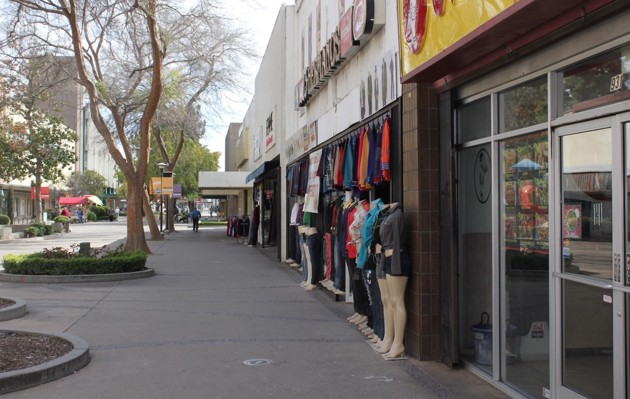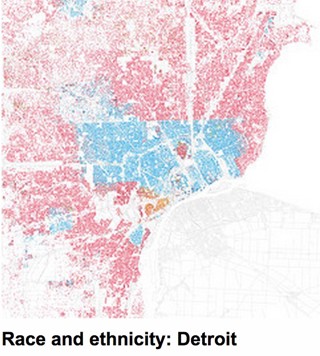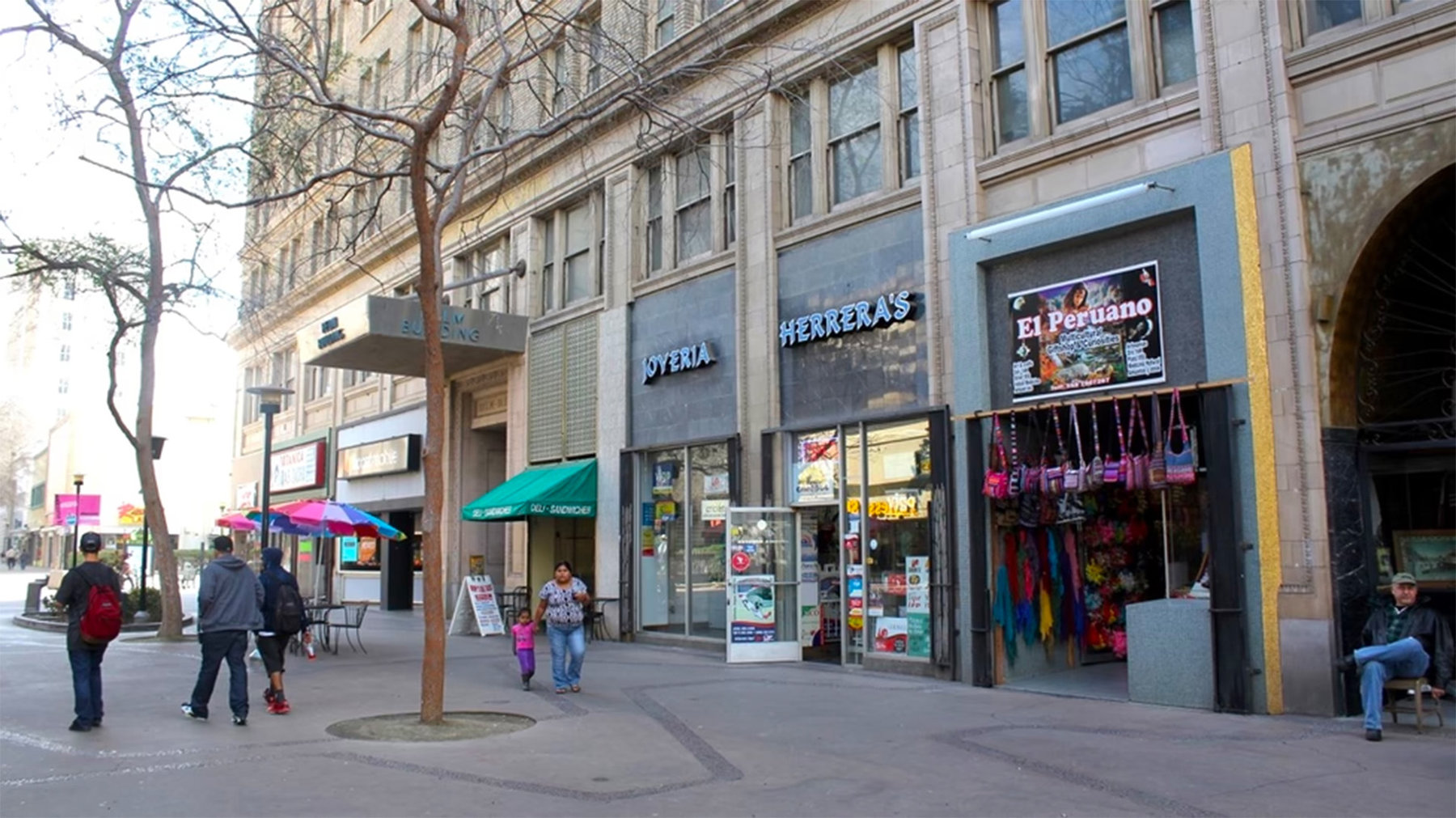Today Deb Fallows has a new item on the improbable tale of Eliza Tibbets, a 19th-century suffragist/spiritualist who is as responsible as anyone else in America for the creation of the West Coast citrus industry. You’ll see what I mean about the improbability if you read the post.
Eliza Tibbets and her husband Luther built an orange empire in the inland-Southern California city of Riverside, which we introduced briefly here before. As Deb points out, Riverside has undertaken a downtown-revitalization project based on exactly the opposite premise from the one now being applied in Fresno, as chronicled most recently here. Fresno has an arty, high-concept, half-century-old pedestrian mall that was once a commercial success but is now a half-occupied distress zone. The city’s solution is to dig up the mall and open Fulton Street once more to cars. Riverside, by contrast, turned its Main Street into a pedestrian mall not long after Fresno did—and it is sticking with that plan.
1) Street-opening worked in Chicago! A reader who works on Wacker Street in downtown Chicago writes:
Chicago Tribune architecture critic, Blair Kamin, wrote an article in 1996 that I think quite nicely relates.
In the mid-1970s, Chicago narrowed State St. to bus only with wide pedestrian walkways. What resulted was an empty-feeling space (even with many pedestrians) where it was hard to easily access the local stores. In 1996, they re-opened State St. to allow cars again, but with much improved pedestrian accommodations. Now, some 20 years on, it’s probably worth noting that that area of State has regained that “city” feel of hustle and bustle as Kamin anticipated.
There have been some changes, with varying degrees of consternation (Marshall Field’s switching to Macy’s still evokes strong passions), but much new development as well. The oldBlock 37 has went from decades-old vacant lot to actual construction and development. Further south, the huge expansion of Roosevelt University has only strengthened the vibrancy of the Loop.
First, this was not a miracle brought forth from a single street re-opening. But, it does show that a city that tries to become a suburb will probably do it poorly. So, play to your strengths. Second, what Fresno’s considering isn’t the first to pursue this type of downtown renovation. Let’s hope their plans are as successful as State Street’s.
Here’s a sample from Kamin’s article, on the importance of urban bustle:
What also should please merchants is the way [a new design] has returned State Street’s sidewalks to their original width, 22 feet instead of as much as 40, which became the rule in 1979. Along with the historical lampposts and subway enclosures, this step compresses the sidewalk, pushing pedestrians closer to display windows. But there is a broader benefit, a feeling of bustle that has been missing from State since 1979. For it is axiomatic that crowds attract more crowds–and that a little jostling is a good thing, part of the street theater that draws people to the city. When it comes to the public realm of the sidewalk, less truly is more.
The NYT had an article at about the same time, called “Chicago Gives Pedestrian Mall the Boot.” Sample quote:
“The mall took the excitement out of State Street,” said Elizabeth Hollander, who was Chicago’s planning commissioner in the 1980’s and is now director of a center for urban affairs at DePaul University. “Planners are rethinking these kinds of urban malls. They’ve learned that cities are different than suburbs. And cities ought to do what cities do best, which is crowd a lot of people together.”
2) Burlington seems like an exception but isn’t really. From a reader who works in downtown Philadelphia:
You are correct, pedestrian mall streets generally deaden the area they are supposed to invigorate. The pedestrian mall on part of Chestnut Street here in Philadelphia failed miserably and was thankfully undone in the 1990s.
One counter though would be Church Street in Burlington, VT, where you visited; however, there are cross streets on Church at close intervals for cars.
3) What about, ahem, the racial and ethnic issue? From a reader in big-city coastal California:
I had no experience with Fresno (save a trip there for a couple days in high school for a club convention) until my best friend moved there to take a job in the mid-1980s. He’s lived there since, and raised a family there, living exclusively in the northern reach of McMansions and strip malls. In my fairly frequent visits during his first decade there, I was struck by two things.
First, what seemed to be a very active and wide spread sports culture. I do not mean watching sports, but participating in sporting activities, community basketball leagues, pick-up softball games, going canoeing on the King River, etc. Without anything else to do in what seemed to be a barren civic landscape, the inhabitants entertained themselves with sports.
The second aspect that caught my attention was the rather prevalent and not well disguised racism of the white residents in the suburbs. They were all quite afraid of downtown because of those who resided there, avoided it like the plague, and considered their hamlets a save but vulnerable haven.
I’m glad to say my friend found these attitudes as repugnant as I did, and he later volunteered at the Boys & Girls Club downtown to supervise basketball games. (I suppose I feel compelled to demonstrate I don’t truck with racists!) Nevertheless, the attitudes I encountered at that time were really quite shocking. I haven’t been back in 20 years, and much could have changed. At least, I hope it has.
I was wondering if in your work on Fresno you encountered any resistance to downtown redevelopment based on “demographic” factors? I don’t want to rain on the city’s parade, but maybe it’s an area for inquiry?

Before responding, let me add a reaction from a reader in Berkeley, California:
Last summer, fate put me in downtown Fresno with some time to kill. It was mid-day and did not take me long to find the [Fulton Street] pedestrian mall.
There were a fair number of people milling about. Old men sitting on benches. Children playing. Some of the restaurants had outdoor seating. A fair number of boutiques and local shops lined the mall. I thought it was awesome. A great place to while away an hour.
But there was one fact that might be relevant to your articles on Fresno: no one was speaking English. The shops sold quinceañera dress and Club America soccer jerseys. The restaurants, all Latin themed.
Reading your articles, I wondered whether this vibrant ethnic scene would be pushed out to the squalid strip malls that lead the way into downtown Fresno. The pedestrian mall is only a block from the recently-built downtown minor league ballpark which has not lived up to its predicted success.
Paving over the pedestrian way would certainly make it easier for the baseball fans to return to their suburban sprawl. I wonder which segment of Fresno’s population is being favored by redevelopment.
In Fresno as in every other American city I’m aware of, white flight from an increasingly “ethnic” downtown has been a major theme of post-World War II sprawl development. Think about it: why else would the term “inner city” have become code for non-white areas? For a set of maps illustrating this phenomenon that everyone is aware of, check out a fascinating Flickr site by Eric Fischer.

Inspired by a renowned ethnic map that Bill Rankin made of Chicago, Fischer populated city maps with dots representing inhabitants of each ethnic group. See if you can guess which color stands for which race in his resulting (and well known) ethnic map of Detroit, at right.
To answer one of these reader-questions, I never heard anyone say, “Oh, it’s so great to be here in the suburbs and away from all those non-white people.” But everyone involved in creating a “California’s next new bohemia” in the arts community of the Tower District, or in downtown renovation in general, worked from the premise that the “urban” qualities of the long-depressed downtown still scared off some of the (largely white) suburbanites.
When we were talking in the Tower District Sequoia Brewery (as distinguished the nearby Tioga-Sequoia brewing company) with some of the figures behind Fresno’s Rogue arts festival, the co-producer, Jonathon Hogan, made this point. “It’s just 15 minutes to drive here from the farthest north side,” he said. Fifteen minutes at most; we cruised around in less time than that. “For someone in L.A., a 15-minute drive means it’s so close you might as well walk. But a lot of people here it’s a big barrier.”
And as for the Berkeley reader’s cui bono concern about which groups will be hurt and helped by downtown redevelopment? I’ll just say: The problems created by gentrification are real. But they are a better class of problems to deal with than those that result from stagnation, which is where Fresno’s downtown has been for too long.




